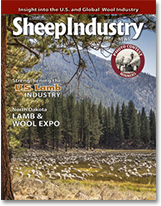Progress Made on Industry’s Top Issues
(Oct. 1, 2013) American Sheep Industry Association (ASI) leadership descended onto Washington, D.C., at the end of August to discuss major areas of concern to the U.S. sheep industry with U.S. Department of Agriculture (USDA) officials. Meeting topics ranged from opening export markets for American lamb to Wildlife Services (WS) and meat inspection and grading.
During the meeting with WS, ASI leadership discussed the status of an agreement with the pest control business that protects the program’s government work which is key to hundreds of cooperators across the country. Early in 2013, pest controllers sought Congressional support to take over key areas of wildlife damage management which is of concern if impacting rural and livestock protection regions. ASI leaders reviewed animal rights activists’ efforts this year to limit tools of livestock protection, including the latest drive to mandate only non-lethal measures or the establishment of a threshold level of lamb kills before WS is engaged.
“ASI met with the newly appointed USDA’s Animal and Plant Health Inspection Service Administrator Kevin Shea,” explains Peter Orwick, ASI executive director. “It was important that the sheep industry meet with Mr. Shea and recognize his support of WS programs and funding.”
Our group thanked him for the letter to the editor to the New York Times defending WS employees from the allegations of animal rights activists. The article can be viewed at www.nytimes.com/2013/08/15/opinion/wildlife-services-mission.html?src=recg&_r=4 &. In addition to WS, scrapie eradication was discussed with Shea.
The group’s next meeting focused on the efforts needed to open up markets for export of American lamb with Suzanne Heinen, acting deputy undersecretary for Farm and Foreign Agricultural Services and previously the administrator of the Foreign Agricultural Service. Earlier this year, the U.S. Meat Export Federation (USMEF) identified key export markets for U.S. lamb and progress has been made to open these markets. USDA officials are awaiting on a response from the Taiwan government for a request for shipment. As far as Japan and Europe are concerned, USDA officials acknowledged these are priority markets that are closed to American lamb today. ASI will continue to work with USMEF and the American Lamb Board to open export markets to American lamb.
The Agricultural Marketing Service (AMS) provided David Bowden, branch chief of AMS Standards, Technology and Promotion Branch, to join the ASI meeting with the Food Safety Inspection Service (FSIS) regarding lamb labeling.
“AMS is working with ASI this year to update the yearling grade category and offered to work with FSIS cooperatively on the topic of lamb,” says Orwick.
However, FSIS Deputy Administrator Philip Derfler, along with his top officials representing both inspectors and label divisions, reminded the ASI group that food safety is their priority rather than marketing topics, although the agency does oversee labels. There is no regulatory definition of lamb at FSIS today. Orwick says that the department is aware of its request for comments on the topic in 1997 and plans to share those comments with the industry.
“Our leaders relayed the industry’s interest in proper lamb labeling,” relays Orwick.
ASI provided a graph that shows the dramatic trend in grading of lamb carcasses. Only 70 percent of the carcasses are being graded today versus 90 percent in the late 1990s, the last time when ASI worked on the definition of lamb. Therefore, 30 percent of the lamb processed today is ungraded with no USDA enforcement of how the no-roll lamb or mutton carcasses are packaged or labeled.
Other meetings that occurred during the visit to D.C. included:
- A presentation by Orwick and Paul Rodgers, ASI deputy director of policy, to the Foreign Animal Disease Threats Working Group. Their concern is if ASI and the sheep industry have an emergency preparedness plan in place, which it does.
- A meeting with Jim Richards of Cornerstone Government Affairs, ASI’s newly selected lobbying group, focused on ASI’s Farm Bill priorities and immigration reform. Richards relayed he had met with the House Committee on Agriculture in support of National Sheep Industry Improvement Center funds for the House and Senate Farm Bill conference.
- A meeting with the new executive director of the Wyoming Wool Growers Association – Amy Hendrickson. Daughter of Sen. Malcolm Wallop, Hendrickson was born and raised in Wyoming and has served as the director of the American Horse Council for a number of years.
- Rodgers met with the now retired Agricultural Research Service (ARS) Administrator Edward Knipling, Ph.D. Under his leadership, ARS has developed a globally recognized program of breeding and genetics for plants and animals. Crops improved by ARS for disease resistance and genetic markers developed for animal selection have advanced U.S. agriculture and improved lives worldwide. Knipling’s retirement brings to a close about eight decades of Knipling family service to ARS and USDA. His father, famed ARS entomologist Edward F. Knipling, Ph.D., made vast contributions to U.S. agriculture – including development of the technology that led to the eradication of the screwworm from the United States, Mexico and Central America.


